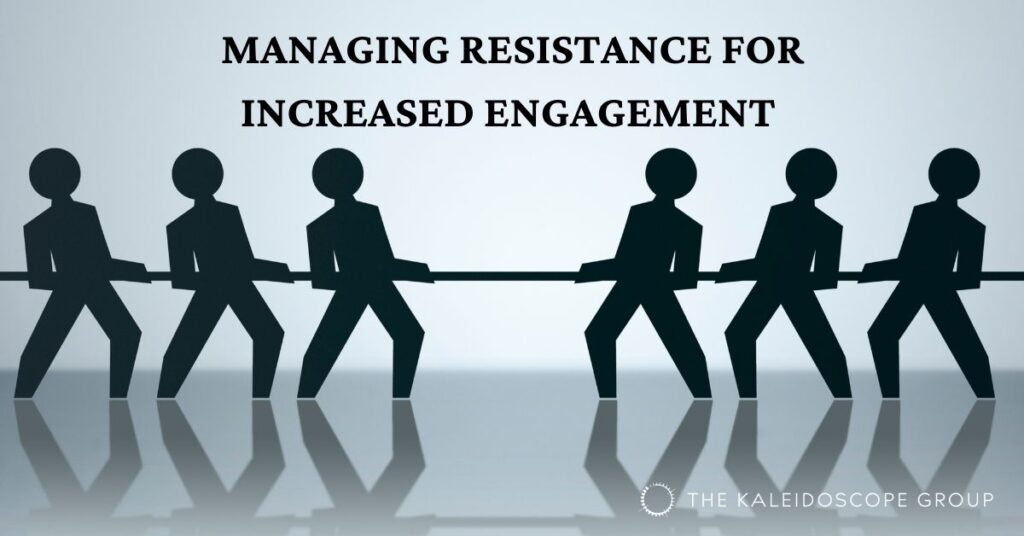Managing Resistance for Increased Engagement
September 27, 2022

A recent study of workplace diversity, equity, and inclusion programs conducted by Culture Amp—an employee engagement firm—found that while 81 percent (81%) of organizations surveyed reported some degree of commitment to DEI initiatives and programs, only 34 percent reported adequate investment in those programs and initiatives. And herein lies the sticking point, according to many DEI professionals and program managers.
To be clear, we are making significant progress if an overwhelming majority see DEI in the workplace as beneficial. That’s a win and we should celebrate it as such. However, it also demonstrates that there’s a great deal of lingering resistance in some quarters—including among leaders—to formalizing and standardizing DEI initiatives by fully investing resources and energy into these programs. That begs the question, “How do we manage resistance to foster greater action, investment, and employee engagement?”
While there are no easy answers, since each organization is unique, there are some best practices that tend to resonate broadly and may be effective in helping to drive the change most of us want, and expect, to see. Following are just a few tips to help make the case for stronger buy-in from leaders, employees, and other stakeholders.
Tips for Managing Resistance
1. Provide Space & Grace
Very often DEI programs are perceived as fostering a “grievance culture” that’s driven by women and/or minority groups within an organization. Approaching DEI from a blame or disciplinary perspective will likely disengage many of your employees. Do leaders, managers, or employees, really want to engage in conversations where they feel the need to be defensive? The old adage, “we attract more flies with honey than vinegar” applies seems apt here. To increase engagement, everyone must have a voice, but everyone has to listen. It’s easy to blame others, but if we’re honest, we all turn off to some degree if we feel attacked, real or perceived.
We’re all complex individuals—and everyone has a story to tell. It’s imperative to the success of any DEI strategy to create a culture where people feel “psychologically safe” telling their stories, asking hard questions, challenging the status quo, or owning up to previous biases that may have been exhibited consciously or unconsciously. Provide your team members with the space and grace to share their perspectives openly and honestly without fear of ostracization.
2. Stress the Business Case
Over recent decades forward-thinking leaders have committed to DEI not only because it was deemed the “right thing to do,” but also because “it’s the smart thing to do for my business.” Two things can be true—and in this case, they certainly are true. It’s not an either/or proposition—focus on my people or focus on my bottom line—it’s a win-win been both are considered holistically. After all, you can’t have a great business without great people. There is any number of validated and reliable peer-reviewed sources to help you make the business case. But in addition to those sources, you should be measuring your organizational performance against your DEI strategy throughout implementation—including things like sales, productivity, recruitment, promotions, compensation, and retention.
3. Build a Culture of Empathy
There’s a great deal of talk about empathy in the workplace today. To some, it feels a bit too “touchy-feely” and has little to do with getting the job done. This is especially true among some older workers and leaders—who developed a set of workplace values that didn’t include concepts of empathy or psychological safety. Empathy means even understanding those who we disagree with based on generational attitudes or other factors. One example from the popular film “Hidden Figures” about a Black female mathematician for NASA illustrated this point when one of the lead characters (based on a real person) was chastised for how long her bathroom breaks took.
She explained to all White male peers and bosses that it took her longer—because she could not use the facilities in the office because they were “Whites Only.” Forcing her to walk blocks to find a restroom she could use. It may have been decades ago when such extreme incidents occurred, but that doesn’t mean people still don’t face barriers unbeknownst to most of us. In a more modern context, consider all the barriers still faced by people living and working with disabilities as yet another real-world example. Without governmental actions like the Americans with Disabilities Act (ADA), many would still be suffering through a lack of accommodations for their unique circumstances. Empathy is key to the effective implementation of the DEI strategy.
4. Embed DEI in Learning & Development
Very often HR programs focused on continuous learning and training include programs like unconscious bias training and sexual harassment in the workplace. But too often that’s where DEI begins and stops, sometimes as only part of the onboarding process. For organizations with the resources for more robust programs, DEI should be an element in most learning platforms. It’s not about achieving a singular end or checking a box. It’s much deeper and more complex than that—especially as related to leadership development programs since these high-potential individuals may be the next generation of leaders.
In addition to embedding DEI content into learning and training, program directors should consider the context, format, modality, and cohorts of these programs. Is the cohort of learners diverse and inclusive? Are the formats and modalities accessible and relevant to all learners within that cohort? These are important considerations for L&D professionals and their DEI peers.
5. Create Champions & Advocates
Over time, with a clear and consistent message and unambiguous goals and objectives, you’ll experience decreases in resistance. However, DEI is a journey, not a quick fix. That said, there is no more effective change agent than peer-to-peer persuasion. We model our professional behaviors based on the behaviors of successful colleagues. These role models exist at every level of an organization and make excellent messengers for increasing engagement and acceptance. DEI is not the sole provenance of leadership, positive change is a shared responsibility; and as such it has to be driven from multiple avenues—horizontally and vertically within an organizational structure. Some companies rely on things like “ally badges” or awareness ribbons to demonstrate this, but that has limited impact as some resisters view it as “virtue signaling.” That doesn’t go to say, that these approaches are ineffective, it just suggests that other strategies are needed to support them.
These are by no means inclusive of everything you can do to manage resistance. Ideas and strategies are abundant, including doing deep dives with identified resisters within your organization. What ideas do you have? What strategies have you successfully used, and which ones have flopped? Let us know. Leave us a comment or question and join the conversation.


